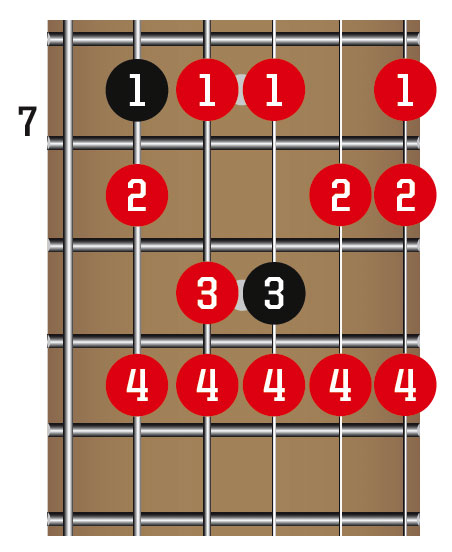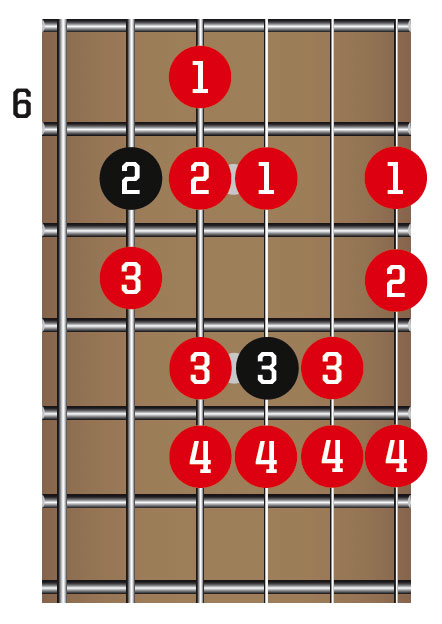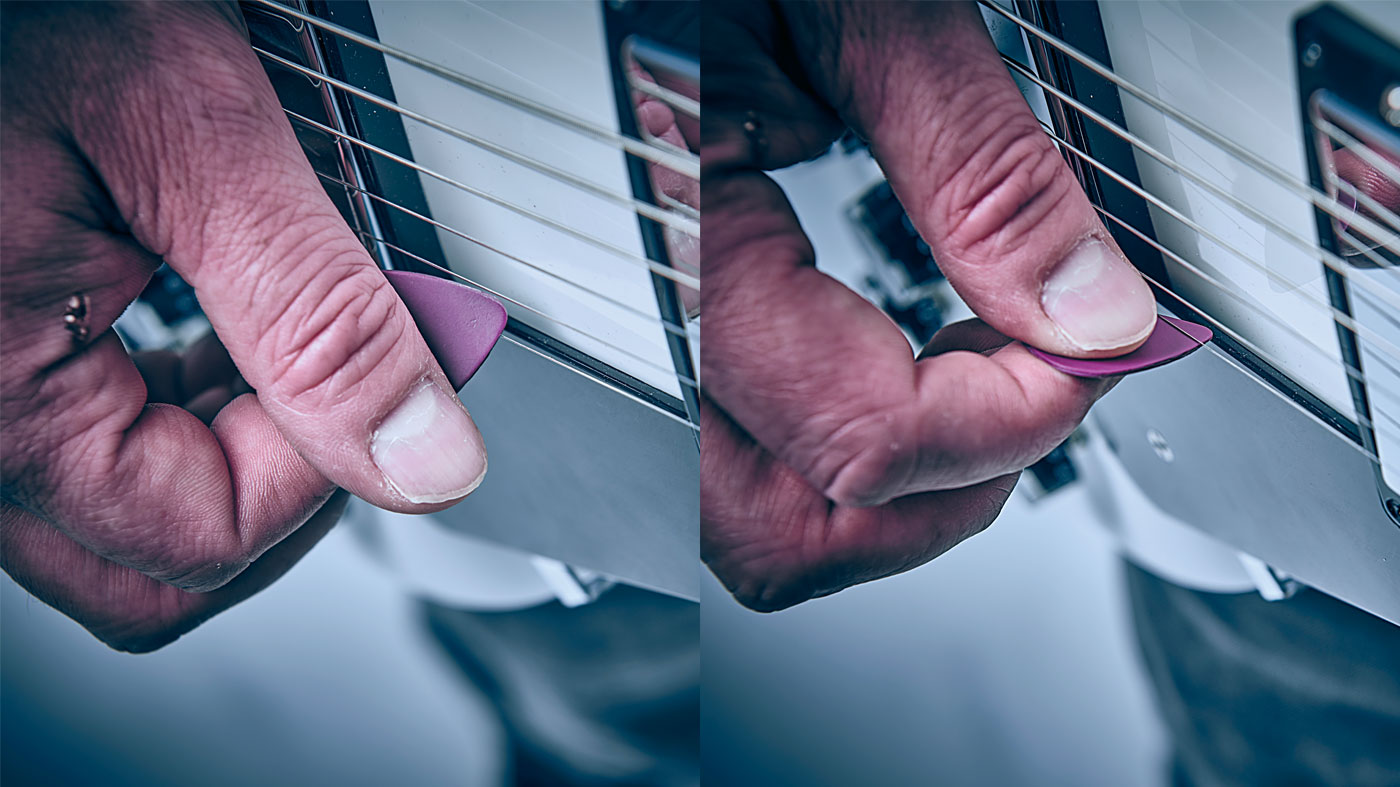Heavy guitar basics: Hard rock and heavy metal six-string essentials, plus 5 top metal solo tips
Grasp the fundamentals and try our easy solo tactics, with tab and audio examples

Guitar lessons:: Aggressive rock and metal guitar styles demandtechnique and timing so here we're focusing on honing a few key abilities.
Furst up, let's take a look at some of the essential building blocks of the genres' hair-raising playing styles.
Phrygian scale

Scale notes (in E): E F G A B C D
Intervals: 1 b2 b3 4 5 b6 b7
When to use it: Metal, especially thrash and also where you see two powerchords one semitone apart. E5 and F5, for example.
Another ‘modal’ choice, this is essentially a minor scale with a dissonant twist. Its exotic sound is often heard in traditional Egyptian and Latin music, but also hard rock and metal from the likes of Kirk Hammett, Marty Friedman and more.
The shape provides an accessible finger pattern with a useful selection of notes to solo with, especially where E5 and F5 chords appear together.
Phrygian dominant scale

Scale notes (in E): E F G# A B C D
Intervals: 1 b2 3 4 5 b6 b7
When to use it: Try it over E5 and F5 powerchords or for a biting lick over a dominant chord - E Phrygian Dominant over an E7 chord.
Just one different note (G#) changes the Phrygian scale to Phrygian Dominant. A more ‘major’ tinged sound, though still retaining the dramatic E to F semitone start, it has more of a progressive vibe so it’s used by bands like Dream Theater, Symphony X and Haken.
Want all the hottest music and gear news, reviews, deals, features and more, direct to your inbox? Sign up here.
1. Palm muting

This technique is a staple in rock and metal in both lead and rhythm parts. Rest the side of your picking hand against the strings where they cross the bridge saddles and play some downstrokes - you’ll hear a much more focused, chunky sound than just picking the string and letting it ring. This is great for keeping clarity on riffs and low register solo lines.
2. Alternate picking

Many of the faster lead lines you’ll hear in rock and metal are a result of alternate down and upstrokes with the pick, aka alternate picking. Generally, onbeat phrases should start with a downstroke - this helps with timing and feeling the pulse of the music. You may find it helpful to angle your pick slightly for a smoother motion across the strings. Aim to keep your grip firm but relaxed.
3. Tapping

Most people first heard this technique from the mighty Eddie Van Halen in the late 70s. By using a picking hand finger to ‘tap’ the string on to the fretboard it’s possible to create complex, fast lines with ease. It works best with a distorted sound, though this isn’t essential. When you’ve tapped and created a note, pull your finger away with a slightly sideways motion rather than just lifting off.
British steel
Inspired by the heavy metal of the late 70s/early 80s, this Phrygian line uses a touch of finger vibrato and palm-muting to embellish what is actually quite a simple line. It’s easy to play this kind of line faster, or add more notes, but does it add intensity? You decide…
In the phryg
It’s easy for a lead line to sound small against the backdrop of huge drums and rhythm guitars, but a little more midrange and a few more notes help this lick stand out. Bars 2 and 4 feature tapping in a relatively slow controlled way. Once you’ve mastered this, its a breeze to speed things up for most impressive results.
5 top tips for metal solos

1. Scooping out your midrange won’t always work
The classic ‘mid-scooped’ tone particularly associated with late 80s and 90s thrash metal is great for rhythm parts but can leave lead tones sounding weedy. If you’re using a scooped tone for your rhythm it’s worth setting up a mid boost for solos. You could use a wah pedal, like Metallica’s Kirk Hammett. Alternatively, an EQ pedal will do the job or a distortion pedal’s tone control may also suffice.
2. How much gain?
Listening to classic metal recordings you’ll find the amount of distortion is lower than you might presume, with perceived saturation and sustain more often a result of sheer volume. There are exceptions to the rule, of course - Gary Moore used a lot of gain on Run For Cover and Wild Frontier. Why not try going lower than you feel you need, only edging the gain up if it’s essential? You’ll fatten your lead tone and reduce hiss and handling noise.
3. Improve your tightness and timing
Rock and metal lead playing is a highly skilled art that leaves little room for sloppiness. The best way to make improvements is the time-honoured method of slow practice with a metronome, drum machine, or any reference point that stops you drifting out of time. Choose a lick that challenges you and start playing at a tempo where you make no mistakes. Repeat it over and again, increasing the speed in roughly 5bpm steps as you gain confidence.
4. Picks and strings improve your tone. And your performance!
The picks and strings you use are among the most crucial factors responsible for your tone. The sound of a super-light set of strings played with a thin pick will be markedly different to a heavier set of strings, perhaps made of a different material and played with a thicker pick. Spend time finding a setup that suits you and you’ll likely find yourself playing at your best.
5. Think about dynamics and pace
In the search for more brutal sounding solos, it’s good to remember to use ‘light and shade’. This can be achieved by varying your guitar tone; perhaps a slow, sustained line on the neck pickup then switching to the bridge pickup for a harder sound. Don’t feel you must fill every space with fast playing. It’s more impressive to mix fast lines into a structure.
MusicRadar is the number one website for music-makers of all kinds, be they guitarists, drummers, keyboard players, DJs or producers...
- GEAR: We help musicians find the best gear with top-ranking gear round-ups and high-quality, authoritative reviews by a wide team of highly experienced experts.
- TIPS: We also provide tuition, from bite-sized tips to advanced work-outs and guidance from recognised musicians and stars.
- STARS: We talk to musicians and stars about their creative processes, and the nuts and bolts of their gear and technique. We give fans an insight into the craft of music-making that no other music website can.


